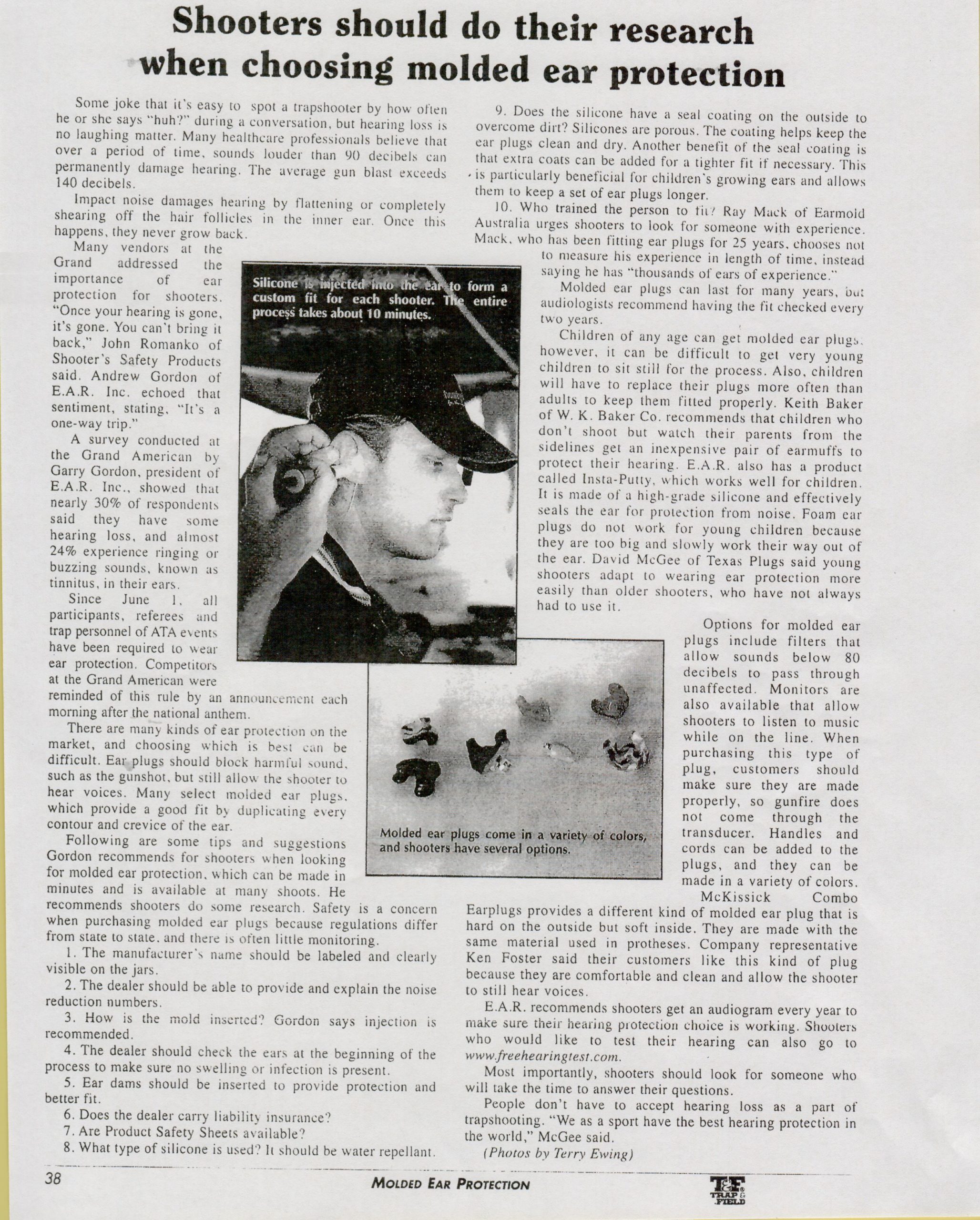- 800.525.2690
- [email protected]
- Mon - Fri: 8:00 - 4:30
Shooters should do their research when choosing molded ear protection

Reprinted from Trap and Field Magazine
Some joke that it’s easy to spot a trapshooter by how often he or she says “huh?” during a conversation, but hearing loss is no laughing matter. Many healthcare professionals believe that over a period of time, sounds louder than 90 decibels can permanently damage hearing. The average gun blast exceeds 140 decibels.
Many vendors at the Grand addressed the importance of ear protection for shooters. “Once your hearing is gone, it’s gone. You can’t bring it back,” John Romanko of Shooter’s Safety Products said. Andrew Gordon of E.A.R. Inc. echoed that sentiment, stating, “It’s a one-way trip.”
A survey conducted at the Grand American by Garry Gordon, president of E.A.R. Inc., showed that nearly 30% of respondents said they have some hearing loss, and almost 24% experience ringing or buzzing sounds, known as tinnitus, in their ears.
Since June 1, all participants, referees and trap personnel of ATA events have been required to wear ear protection. Competitors at the Grand American were reminded of this rule by an announcement morning after the national anthem.
There are many kinds of ear protection on the market, and choosing which is best can he difficult. Ear plugs should block harmful sound, such as the gunshot, but still allow the shooter to hear voices. Many select molded ear plugs. which provide a good fit by duplicating every contour and crevice of the ear.
Following are some tips and suggestions Gordon recommends for shooters when looking for molded ear protection, which can be made in minutes and is available at many shoots. He recommends shooters do sonic research. Safety is a concern when purchasing molded ear plugs because regulations differ from state to state, and there is often little monitoring.
- The manufacturer’s name should be labeled and clearly visible on the jars.
- The dealer should be able to provide and explain the noise reduction numbers.
- How is the mold inserted’? Gordon says injection is recommended.
- The dealer should check the ears at the beginning of the process to make sure no swelling or infection is present.
- Ear dams should be inserted to provide protection and better fit.
- Does the dealer carry liability insurance’?
- Are Product Safety Sheets available?
- What type of silicone is used? It should be water repellant.
- Does the silicone have a seal coating on the outside to overcome dirt? Silicones are porous. The coating helps keep the ear plugs clean and dry. Another benefit of the seal coating is that extra coats can be added for a tighter fit if necessary. This • is particularly beneficial for children’s growing ears and allows them to keep a set of ear plugs longer.
- Who trained the person to fit! Ray Mack of Earmoid Australia urges shooters to look for someone with experience. Mack, who has been fitting ear plugs for 25 years, chooses not to measure his experience in length of time, instead saying he has “thousands of ears of experience.”
Molded ear plugs can last for many years, but audiologists recommend having the fit checked every two years.
Children of any age can get molded ear plugs, however, it can be difficult to get very young children to sit still for the process. Also, children will have to replace their plugs more often than adults to keep them fitted properly. Keith Baker of W. K. Baker Co. recommends that children who don’t shoot but watch their parents from the sidelines get an inexpensive pair of earmuffs to protect their hearing.
E.A.R. also has a product called ‘Insta-Putty’, which works well for children. It is made of a high-grade silicone and effectively seals the ear for protection from noise. Foam ear plugs do not work for young children because they are too big and slowly work their way out of the ear. David McGee of Texas Plugs said young shooters adapt to wearing ear protection more easily than older shooters, who have not always had to use it.
Options for molded ear plugs include filters that allow sounds below 80 decibels to pass through unaffected. Monitors are also available that allow shooters to listen to music while on the line. When purchasing this type of plug, customers should make sure they are made properly, so gunfire does not come through the transducer. Handles and cords can be added to the plugs, and they can be made in a variety of colors.
McKissick Combo Earplugs provides a different kind of molded ear plug that is hard on the outside but soft inside. They are made with the same material used in protheses. Company representative Ken Foster said their customers like this kind of plug because they are comfortable and clean and allow the shooter to still hear voices.
E.A.R. recommends shooters get an audiogram every year to make sure their hearing protection choice is working. Shooters who would like to test their hearing can also go to www.freehearingtest.com.
Most importantly, shooters should look for someone who will take the time to answer their questions.
People don’t have to accept hearing loss as a part of trapshooting. “We as a sport have the best hearing protection in the world,” McGee said.
(Photos by Terry Ewing)
